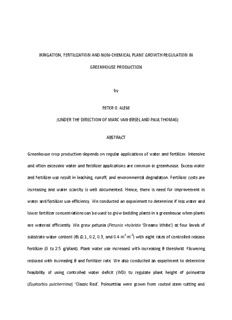
Irrigation, fertilization and non-chemical plant growth regulation in greenhouse production PDF
Preview Irrigation, fertilization and non-chemical plant growth regulation in greenhouse production
IRRIGATION, FERTILIZATION AND NON-CHEMICAL PLANT GROWTH REGULATION IN GREENHOUSE PRODUCTION by PETER O. ALEM (UNDER THE DIRECTION OF MARC VAN IERSEL AND PAUL THOMAS) ABSTRACT Greenhouse crop production depends on regular applications of water and fertilizer. Intensive and often excessive water and fertilizer applications are common in greenhouse. Excess water and fertilizer use result in leaching, runoff, and environmental degradation. Fertilizer costs are increasing and water scarcity is well documented. Hence, there is need for improvement in water and fertilizer use efficiency. We conducted an experiment to determine if less water and lower fertilizer concentrations can be used to grow bedding plants in a greenhouse when plants are watered efficiently. We grew petunia (Petunia ×hybrida ‘Dreams White’) at four levels of substrate water content (θ) (0.1, 0.2, 0.3, and 0.4 m3·m-3) with eight rates of controlled release fertilizer (0 to 2.5 g/plant). Plant water use increased with increasing θ threshold. Flowering reduced with increasing θ and fertilizer rate. We also conducted an experiment to determine feasibility of using controlled water deficit (WD) to regulate plant height of poinsettia (Euphorbia pulcherrima) ‘Classic Red’. Poinsettias were grown from rooted stem cutting and exposed to WD or plant growth regulators (PGR) to control stem elongation. Regulated water deficit resulted in an average height of 44.5 cm, closest to the target height (43.5 cm). However, there are limits on how much height control can be achieved through WD. For ‘Classic Red’, a high vigor cultivar, the lowest height limit achievable with WD is 39-40 cm. Application of long durations of WD reduced bract area. To understand how irrigation regimes and fertilizer concentrations affect leaching and growth of bedding plants, petunias were grown with two fertilizer concentrations (100 and 200 mg∙L-1 N) and four irrigation volumes, control (minimal leaching), low, medium and high. The higher fertilizer concentration (200 vs. 100 mg∙L-1 N) resulted in larger plants, regardless of irrigation and leaching volumes. The larger plants had greater water use and thus needed more frequent irrigation to replenish the used water. Both large irrigation volumes and more frequent irrigation increases leaching if θ is close to container capacity. More efficient irrigation reduced the amount of water, and thus water-soluble fertilizer, that was applied. INDEX WORDS: Ageratum, daily light integral, dianthus, efficient irrigation, impatiens, leaching, petunia, plant growth regulators, poinsettias, soil moisture sensors, vapor pressure deficit, water deficit. IRRIGATION, FERTILIZATION AND NON-CHEMICAL PLANT GROWTH REGULATION IN GREENHOUSE PRODUCTION by PETER O. ALEM B.S., Jomo Kenyatta University of Agriculture and Technology, Kenya, 2008 M.S., Clemson University, South Carolina, USA, 2010 A Dissertation submitted to the Graduate School of The University of Georgia in Partial Fulfillment of the Requirements for the Degree DOCTOR OF PHILOSOPHY ATHENS, GEORGIA 2014 ©2014 PETER O. ALEM All rights Reserved IRRIGATION, FERTILIZATION AND NON-CHEMICAL PLANT GROWTH REGULATION IN GREENHOUSE PRODUCTION by PETER O. ALEM Major Professor: Marc W. van Iersel Paul Thomas Committee: Anish Malladi Lisa Donovan Sheryl Wells Matthew Chappell Electronic Version Approved: Julie Coffield Interim Dean of the Graduate School The University of Georgia August 2014 DEDICATION I dedicate this dissertation to the memory of my mother (Akumu Alem) and father (Yonah Alem) and the humble life they led. They never went to school, lived and died in a small village in Kenya and they had unconditional love for us. iv ACKNOWLEDGEMENT My sincere gratitude and appreciation goes to my major advisor, Dr. Marc van Iersel. I am lucky to have had him as my mentor who encouraged and taught me lifelong skills for my career. He was a good leader and someone to look up to in many aspects of my career development. Marc was very friendly and open to discussion at any time and cared enough to correct me when I was wrong. I would also like to thank Dr. Lisa Donovan, Dr. Paul Thomas, Dr. Anish Malladi and Dr. Mathew Chappell for serving in my committee. I would also like to thank Miss Sue Dove who facilitated my work and made everything available whenever I needed them. She was a great support, cheerful and kept the lab lively. Finally, I thank my master’s advisor Dr. Jim Faust of Clemson University for facilitating my coming to the USA and a successful career path. v TABLE OF CONTENTS Page ACKNOWLEDGEMENTS .................................................................................................................... v LIST OF TABLES ................................................................................................................................ ix LIST OF FIGURES ............................................................................................................................... x CHAPTER 1 INTRODICTION .............................................................................................................. 1 General Objectives .................................................................................................. 3 References .............................................................................................................. 4 2 LITERATURE REVIEW ..................................................................................................... 7 Irrigation and Leaching Dynamics in Greenhouse Production ............................... 7 Soil Moisture Sensors Controlled Irrigation System ............................................... 9 Irrigation, Fertilizer and their Interactive Effects on Container-grown plants .... 11 Controlled Deficit Irrigation as an Alternative to Chemical Plant Growth regulation .............................................................................................................. 13 Literature Cited ..................................................................................................... 15 3 GROWTH OF PETUNIA AS AFFECTED BY FERTILIZER RATE AND SUBSTRATE WATER CONTENT ........................................................................................................ 29 Abstract ................................................................................................................. 30 Introduction .......................................................................................................... 31 vi Materials and Methods ......................................................................................... 33 Results and Discussions ........................................................................................ 36 Conclusions ………………………………………………………………………………………………………42 Acknowledgements............................................................................................... 43 Literature cited...................................................................................................... 43 4 IRRIGATION VOLUME AND FERTILIZER CONCENTRATION EFFECTS ON LEACHING AND GROWTH OF PETUNIA ....................................................................... 62 Abstract ................................................................................................................. 63 Introduction .......................................................................................................... 64 Materials and Method .......................................................................................... 65 Results and Discussion .......................................................................................... 67 Conclusions ...................................................................................................... 68 Acknowledgements............................................................................................... 69 Literature cited...................................................................................................... 69 5 USE OF CONTROLLED WATER DEFICIT TO CONTROL POINSETTIAS HEIGHT .............. 74 Abstract ................................................................................................................. 75 Introduction .......................................................................................................... 76 Materials and Methods ......................................................................................... 79 Results and Discussions ........................................................................................ 82 Conclusions …………………………………………………………………………………………… .......... 86 Acknowledgements............................................................................................... 86 vii Literature cited...................................................................................................... 87 6 CONTROL OF POINSETTIA STEM ELONGATION BY VARYING SUBSTRATE WATER CONTENT ..................................................................................................................... 99 Abstracts ............................................................................................................. 100 Introduction …… .................................................................................................. 101 Materials and Methods ....................................................................................... 102 Results and Discussions ...................................................................................... 106 Conclusions ........................................................................................................ 111 Acknowledgements............................................................................................. 111 Literature cited.................................................................................................... 111 7 CONCLUSIONS .......................................................................................................... 127 viii
Description: